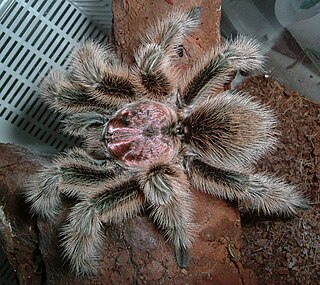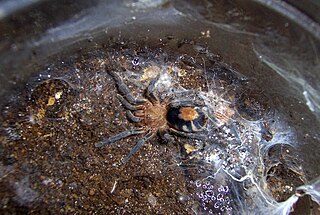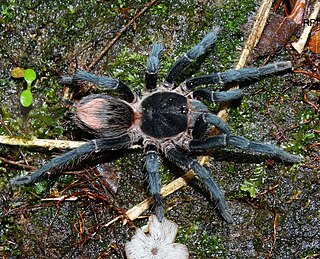
Dwarf sheet spiders (Hahniidae) is a family of araneomorph spiders, first described by Philipp Bertkau in 1878. Their bodies are about 2 millimetres (0.079 in) long, and they build extremely delicate webs in the form of a sheet. Unlike many spiders the web does not lead to a retreat. The silk used in these webs is so fine that they are difficult to spot unless they are coated with dew. They greatly favor locations near water or near moss, and are often found in leaf litter and detritus or on the leaves of shrubs and trees.

Grammostola is a genus of South American tarantulas that was first described by Eugène Louis Simon in 1892. These medium to large sized spiders are native to tropical South America, and are usually brown in color, with pinkish or orangish-red hairs. The very docile Chilean rose tarantulas are popular as a beginner's spider among tarantula enthusiasts.

Diplura is a genus of South American curtain web spiders that was first described by C. L. Koch in 1850. It is found in South America and Cuba belonging to the subfamily Diplurinae. They possess a lyra on their prolateral maxillae. Diplura species can be distinguished from Trechona sp. by the number of setae on this lyra. They differ from Harmonicon sp. by the leg formula and the shape of the lyra bristles.

Cyriocosmus is a genus of tarantulas that was first described by Eugène Louis Simon in 1903.
Cyclosternum is a genus of tarantulas that was first described by Anton Ausserer in 1871.

The Theraphosinae are a large subfamily of Mygalomorphae spiders in the family Theraphosidae found in the Neotropical realm.
Tmesiphantes uru is a species of tarantula in the theraphosinae subfamily. It is endemic to Argentina.
Tmesiphantes mutquina is a species of theraphosid spider, in the subfamily Theraphosinae. It is native to Argentina.
Tmesiphantes yupanqui is a species of spider in the subfamily Theraphosinae of the family Theraphosidae. It is endemic to Argentina.

Acanthogonatus is a genus of South American araneomorph spiders in the family Pycnothelidae. It was first described by Ferdinand Anton Franz Karsch in 1880. Originally placed with the brushed trapdoor spiders, it was transferred to the funnel-web trapdoor spiders in 1985, then to the Pycnothelidae in 2020.
Tmesiphantes is a genus of Brazilian tarantulas in the subfamily Theraphosinae that was first described by Eugène Louis Simon in 1892. The genera Magulla and Melloleitaoina were brought into synonymy in 2019.
Amaloxenops is a genus of South American dwarf sheet spiders that was first described by R. D. Schiapelli & B. S. Gerschman de P. in 1958. As of May 2019 it contains only two species, both found in Argentina: A. palmarum and A. vianai.

Calathotarsus is a genus of spiders in the family Migidae. It was first described in 1903 by Eugène Simon. As of 2016, it contains 3 species, occurring in Chile and Argentina.

Homoeomma is a genus of South American tarantulas that was first described by Anton Ausserer in 1871. It is considered a senior synonym of Calopelma, Butantania, and of Cyclothoracoides.
Plesiopelma is a genus of South American tarantulas that was first described by Reginald Innes Pocock in 1901.
Pycnothele is a genus of South American mygalomorph spiders in the family Pycnothelidae. First described by Ralph Vary Chamberlin in 1917, it was moved to the funnel-web trapdoor spiders in 1985, but moved back to Pycnothelidae in 2020. It is a senior synonym of Agersborgia and Androthelopsis.
Xenoplectus is a monotypic genus of South American liocranid sac spiders containing the single species, Xenoplectus armatus. It was first described by R. D. Schiapelli & B. S. Gerschman de P. in 1958, and has only been found in Argentina.
Paracleocnemis is a genus of Argentinian running crab spiders that was first described by R. D. Schiapelli & B. S. Gerschman in 1942. As of June 2019 it contains only two species, found only in Argentina: P. apostoli and P. termalis.
Homoeomma elegans is a species of spiders in the family Theraphosidae. It is found in Argentina.







